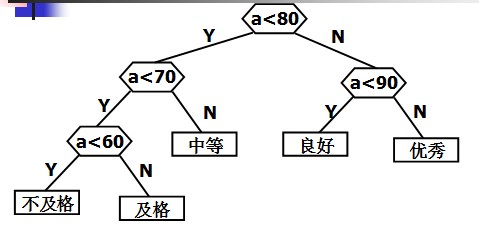标签:style blog http color io os 使用 ar for
一、哈夫曼树的概念和定义
什么是哈夫曼树?
让我们先举一个样例。
判定树:
if(score<60) cout<<"Bad"<<endl; else if(score<70) cout<<"Pass"<<endl else if(score<80) cout<<"General"<<endl; else if(score<90) cout<<"Good"<<endl; else cout<<"Very good!"<<endl;



定义哈夫曼树之前先说明几个与哈夫曼树有关的概念:
路径: 树中一个结点到还有一个结点之间的分支构成这两个结点之间的路径。
路径长度:路径上的分枝数目称作路径长度。
树的路径长度:从树根到每个结点的路径长度之和。
结点的带权路径长度:在一棵树中,假设其结点上附带有一个权值,通常把该结点的路径长度与该结点上的权值
之积称为该结点的带权路径长度(weighted path length)
什么是权值?( From 百度百科 )
计算机领域中(数据结构)
权值就是定义的路径上面的值。能够这样理解为节点间的距离。通常指字符相应的二进制编码出现的概率。
至于霍夫曼树中的权值能够理解为:权值大表明出现概率大!
一个结点的权值实际上就是这个结点子树在整个树中所占的比例.
abcd四个叶子结点的权值为7,5,2,4. 这个7,5,2,4是依据实际情况得到的,比方说从一段文本中统计出abcd四个字母出现的次数分别为7,5,2,4. 说a结点的权值为7,意思是说a结点在系统中占有7这个份量.实际上也能够化为百分比来表示,但反而麻烦,实际上是一样的.
树的带权路径长度:假设树中每一个叶子上都带有一个权值,则把树中全部叶子的带权路径长度之和称为树的带
权路径长度。
设某二叉树有n个带权值的叶子结点,则该二叉树的带权路径长度记为:

公式中,Wk为第k个叶子结点的权值;Lk为该结点的路径长度。
演示样例:

二、哈夫曼树的构造


三、哈夫曼树的在编码中的应用

#include<iostream>
#include<cstdio>
#include<cstring>
using namespace std;
#define N 10 // 带编码字符的个数,即树中叶结点的最大个数
#define M (2*N-1) // 树中总的结点数目
class HTNode{ // 树中结点的结构
public:
unsigned int weight;
unsigned int parent,lchild,rchild;
};
class HTCode{
public:
char data; // 待编码的字符
int weight; // 字符的权值
char code[N]; // 字符的编码
};
void Init(HTCode hc[], int *n){
// 初始化,读入待编码字符的个数n,从键盘输入n个字符和n个权值
int i;
printf("input n = ");
scanf("%d",&(*n));
printf("\ninput %d character\n",*n);
fflush(stdin);
for(i=1; i<=*n; ++i)
scanf("%c",&hc[i].data);
printf("\ninput %d weight\n",*n);
for(i=1; i<=*n; ++i)
scanf("%d",&(hc[i].weight) );
fflush(stdin);
}//
void Select(HTNode ht[], int k, int *s1, int *s2){
// ht[1...k]中选择parent为0,而且weight最小的两个结点,其序号由指针变量s1,s2指示
int i;
for(i=1; i<=k && ht[i].parent != 0; ++i){
; ;
}
*s1 = i;
for(i=1; i<=k; ++i){
if(ht[i].parent==0 && ht[i].weight<ht[*s1].weight)
*s1 = i;
}
for(i=1; i<=k; ++i){
if(ht[i].parent==0 && i!=*s1)
break;
}
*s2 = i;
for(i=1; i<=k; ++i){
if(ht[i].parent==0 && i!=*s1 && ht[i].weight<ht[*s2].weight)
*s2 = i;
}
}
void HuffmanCoding(HTNode ht[],HTCode hc[],int n){
// 构造Huffman树ht,并求出n个字符的编码
char cd[N];
int i,j,m,c,f,s1,s2,start;
m = 2*n-1;
for(i=1; i<=m; ++i){
if(i <= n)
ht[i].weight = hc[i].weight;
else
ht[i].parent = 0;
ht[i].parent = ht[i].lchild = ht[i].rchild = 0;
}
for(i=n+1; i<=m; ++i){
Select(ht, i-1, &s1, &s2);
ht[s1].parent = i;
ht[s2].parent = i;
ht[i].lchild = s1;
ht[i].rchild = s2;
ht[i].weight = ht[s1].weight+ht[s2].weight;
}
cd[n-1] = ‘\0‘;
for(i=1; i<=n; ++i){
start = n-1;
for(c=i,f=ht[i].parent; f; c=f,f=ht[f].parent){
if(ht[f].lchild == c)
cd[--start] = ‘0‘;
else
cd[--start] = ‘1‘;
}
strcpy(hc[i].code, &cd[start]);
}
}
int main()
{
int i,m,n,w[N+1];
HTNode ht[M+1];
HTCode hc[N+1];
Init(hc, &n); // 初始化
HuffmanCoding(ht,hc,n); // 构造Huffman树,并形成字符的编码
for(i=1; i<=n; ++i)
printf("\n%c---%s",hc[i].data,hc[i].code);
printf("\n");
return 0;
}
标签:style blog http color io os 使用 ar for
原文地址:http://www.cnblogs.com/hrhguanli/p/4020505.html